#suspension Eno studio
Explore tagged Tumblr posts
Text
Ne faites pas chapeau bas à ces drôles de luminaires !
Ne faites pas chapeau bas à ces drôles de luminaires !

Le chapeau est un accessoire qui existait déjà à l’Antiquité ! Au fil des époques, les chapeaux prennent différentes formes selon les tendances et aussi les cultures.
En effet, dans certaines cultures, le chapeau était primordial pour distinguer différentes classes sociales. Il est également utilisé pour se protéger du temps, comme dans les pays chauds; le chapeau est le meilleur ami de l’homme…
View On WordPress
#Applique chapeau#chapeau atelier pierre#chapeau innermost#chapeau karman#lampe chapeau#lampe chapeau hat eno studio#luminaire chapeau#suspension chapeau#suspension chapeau carmen
0 notes
Text
Personality Crisis: The Radical Fluidity of Todd Haynes’ ‘Velvet Goldmine’ by Judy Berman
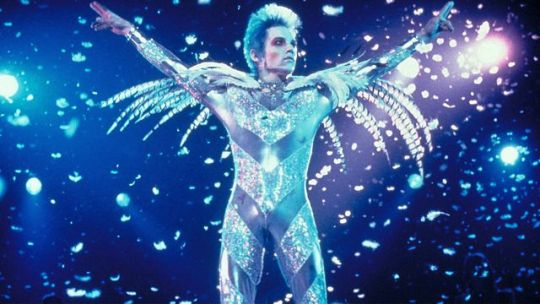
[This month, Musings pays homage to Produced and Abandoned: The Best Films You’ve Never Seen, a review anthology from the National Society of Film Critics that championed studio orphans from the ‘70s and ‘80s. In the days before the Internet, young cinephiles like myself relied on reference books and anthologies to lead us to film we might not have discovered otherwise. Released in 1990, Produced and Abandoned was a foundational piece of work, introducing me to such wonders as Cutter’s Way, Lost in America, High Tide, Choose Me, Housekeeping, and Fat City. (You can find the full list of entries here.) Over the next four weeks, Musings will offer its own selection of tarnished gems, in the hope they’ll get a second look. Or, more likely, a first. —Scott Tobias, editor.]
Like the glam rockers it gazes upon through the smoke-clouded lens of memory, Velvet Goldmine is most beautiful when it descends into chaos.
Stolen, the way great artists do, from Citizen Kane, the skeleton of Todd Haynes’ 1998 film is a chain of interlocking reminiscences of Brian Slade (Jonathan Rhys Meyers), a David Bowie-like glam rocker who fakes his own onstage death in the mid-’70s. A decade later—in that most dystopic of years, 1984—his ex-wife Mandy (Toni Collette) and former manager Cecil (Michael Feast) relate their bitter tales of betrayal to a journalist (Christian Bale) whose assignment has him reluctantly reliving his own teenage sexual awakening under the influence of Brian’s music. Between the interviews, musical numbers, and onscreen epigrams, there’s also a mysterious female narrator who sometimes surfaces, like a teacher reading a subversive storybook, with dreamy exposition that reaches back a century to invoke glam’s patron saint, Oscar Wilde.
The film climaxes with a propulsive sequence of scenes that are exhilarating precisely because they merge all of these points of view, subjective and omniscient, into one collective fantasy. Brian and his new conquest, the Iggy Pop/Lou Reed composite Curt Wild (Ewan McGregor), ride mini spaceships at a carnival to Reed’s “Satellite of Love.” Two random schoolgirls, their faces obscured, act out a love scene between a Curt doll and a Brian doll. In a posh hotel lobby, Brian’s entourage, styled like Old Hollywood starlets on the Weimar Germany set of a fin-de-siècle period film, recites pilfered sound bites about art. Then Brian and Curt are kissing on a circus stage, surrounded by old men in suits. They play Brian Eno’s “Baby’s on Fire” as Haynes cuts between the performance, an orgy in their hotel suite, and Bale’s hapless, young Arthur Stuart masturbating over a newspaper photo of Brian fellating Curt’s guitar. Stripped of narration—not to mention narrative—the film seems to be running on its own amorous fumes, its story fragmenting into a heap of glittering images as it hurtles from set piece to set piece.
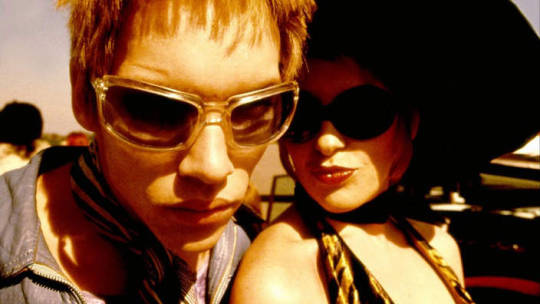
Visual pleasure aside, it’s a perfect way of translating into cinematic language the argument that underlies Haynes’ script—that glam’s revelations about the radical fluidity of human identity go far beyond sex and gender. As the apotheosis of teen pop audiences’ thirst for outsize personae, fictional characters like Ziggy Stardust (who Velvet Goldmine further fictionalizes as Slade’s alter ego, Maxwell Demon) melded the symbiotic identities of artist and fan into a single, tantalizing vision of hedonism and transgression. Kids imitated idols they didn’t quite recognize as pure manifestations of their own inchoate desires. Musician and fan became each other’s mirror, and both could become entirely new people simply by changing costumes or names.
But it’s pretty much impossible to imagine Velvet Goldmine’s distributor and co-producer, Harvey Weinstein, appreciating this as he watched the film for the first time—or seeing anything in it, really, besides an expensive mess.
Haynes and his loyal producing partner, Killer Films head Christine Vachon, had already been through hell with Velvet Goldmine by the time they delivered a cut to Miramax. Bowie had refused Haynes’ repeated requests for permission to use six Ziggy-era songs in the film, claiming that he had a glam movie of his own in the works. And in a production diary that appears in her book Shooting to Kill, Vachon points out one unique challenge of making a film about queer male sexuality: “The MPAA seems to have a number of double standards. Naked females get R ratings, but pickle shots tend to get NC-17s. Our Miramax contract obligates us to an R.” She also mentions that an investor pulled $1 million of funding just weeks before filming.
The shoot was even more harrowing than the two veteran indie filmmakers could’ve predicted. As they fell behind schedule, a production executive started nagging Vachon to make cuts. “Todd is miserable,” she wrote in her diary the night before they wrapped. “He says that making movies this way is awful and he doesn’t want to do it.” In an interview that accompanies the published screenplay for Velvet Goldmine, Oren Moverman asks Haynes, “Was the making of the film joyful for you?” “I’m afraid not,” he replies. “We were trying very hard to cut scenes while shooting, knowing that we were behind and we didn’t have the money for the overloaded schedule. But there was hardly a scene we could cut without losing essential narrative information.” It’s remarkable that he managed to capture 123 usable minutes’ worth of meticulously art-directed ‘70s excess (and ‘80s bleakness) in just nine weeks, under so much external pressure, on a budget of $7 million.
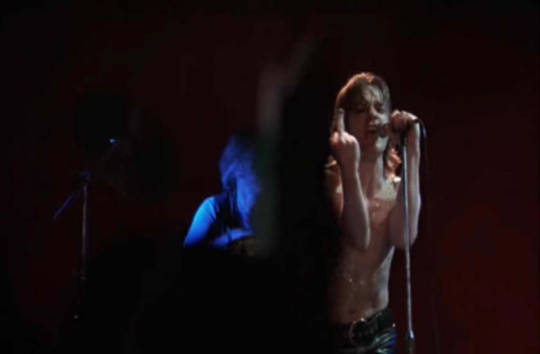
When the film finally reached Harvey Scissorhands, after months of editing, Weinstein told Haynes it was too long and the structure didn’t work. “He made suggestions that I didn’t follow, and then he just buried it,” the director told Down and Dirty Pictures author Peter Biskind. What happened next comes straight from the Weinstein playbook: “Even afterward,” Haynes remembered, “they threw out a DVD, they didn’t ask for a director commentary, my name wasn’t on the cover of it, it was buried in the minuscule billing block. He can’t even do the really small things that don’t cost anything—he never shows any respect.” (That Haynes never found a distributor he preferred to Weinstein, with whom he reunited for I’m Not There and Carol, speaks volumes about the way Hollywood treats ambitious filmmakers.)
After it failed to blow audiences away at the 1998 Cannes Film Festival, Miramax effectively dumped Velvet Goldmine. It debuted on just 85 screens that November, ultimately grossing about $1 million stateside. Its ridiculous theatrical trailer might well be a glimpse at the movie Weinstein was expecting: a “magical trip back to the ‘70s” with 100% more murder mystery and 100% less gay sex.
Critics were just as ambivalent about the film as festival audiences. While forward-thinking reviewers wanted to love it for its visual beauty and openly queer aesthetic, many lamented that its plot was slight and its characters hollow. David Ansen of Newsweek complained that “Haynes is unwilling to get too close to his characters. Slade, in particular, is a blank”—failing to see that Brian is a cypher by design. Like the Barbie-doll Karen Carpenter of Haynes’ debut feature, Superstar, and the fragments of Bob Dylan diffused across I’m Not There, Velvet Goldmine’s Bowie is less a portrait of the real person than a screen on which fans project their own fantasies about him.
At The Nation, Stuart Klawans rightly identified Arthur, not Brian, as the film’s protagonist. But he also wondered why he grows up to be such an unhappy adult. “Why is Haynes so tough on Arthur?” Klawans wanted to know. “Why, through the character, is he so tough on himself? It’s apparent everywhere in Velvet Goldmine that Haynes, like Arthur, loves Glitter Rock. He, too, fell for a mass-marketed product, which was no more likely than Mr. Clean to carry out a world-transforming promise. But instead of honoring the truth of his enthusiasm, so that he might look back on its object with a smile and a sigh…Haynes does penance for being a sap.”
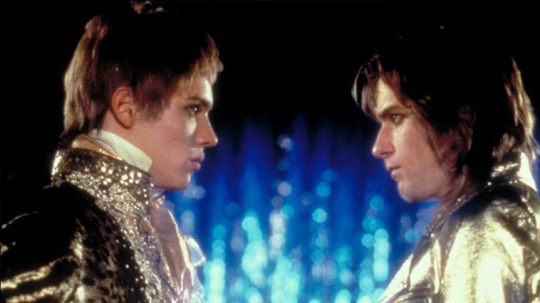
Others found the film’s collage of ideas and allusions cumbersome. “Velvet Goldmine is weighed down with self-important messages, but it’s also splashily opulent,” Stephanie Zacharek wrote at Salon. “It’s as if Todd Haynes had plunged his hand into a pile of clothes at a jumble sale and come out with a handful that was half velvet finery, half polyester rejectables.”
All of these reactions make sense, coming from adult critics who had probably seen the film just once, after reading months’ worth of reports about its troubled birth, in the sterile environment of a press screening. But what’s clear from a distance of nearly two decades, during which Velvet Goldmine has become a low-key cult classic, is that few films are so poorly suited to be judged on the basis of a single dispassionate viewing. If you’re looking for tight plotting and complex characters, you’re not going to find them in this mixtape of music videos, aphorisms, and waking dream sequences. There is no actual murder mystery, and Arthur’s investigation into Slade’s disappearance isn’t a source of suspense so much as an excuse to keep contrasting an incandescent past with a dull, gray present.
I’m lucky enough to have first encountered Velvet Goldmine under what turned out to be ideal circumstances: at age 15, on premium cable, late enough at night that it easily bypassed my rational mind en route to my adolescent subconscious. I had no idea how many details it cribbed from the biographies of Bowie and his contemporaries, or how much of the dialogue was quoted from their (and their heroes’) most memorable utterances. I bought the soundtrack without realizing that it put ‘70s originals side-by-side with contemporary covers and new songs by younger bands like Pulp and Shudder to Think in yet another glam pastiche. It wouldn’t have occurred to me to find the 1984 scenes unsatisfying because I got so instantly immersed in the ‘70s spectacles that they barely existed for me.
Not that the film only works on an emotional level. Haynes’ ideas about fandom, politics, sexuality, and identity become even more profound once you can see the organizing principle behind what might initially seem like a jumble of indulgent images. Like the death hoax Brian Slade uses to escape a fantasy life that’s grown too real for comfort, Velvet Goldmine’s loose plot is classic misdirection, obscuring a tight and purposeful structure that delays the resolution of the ‘80s storyline until it’s primed you to feel the loss of the liberated ‘70s viscerally. But you’ll never get that far into dissecting the film if you don’t fall in love with it at first viewing. And that’s easiest to do when you’re as impressionable as young Arthur, who watches Brian Slade flaunt his queerness in a televised press conference and imagines himself shouting to his parents, “That is me!”
Revisit it as you grow older, though, and you might discover that the disillusioned 30-something characters now feel as rich as their idealistic former selves. Velvet Goldmine is often called a gay film, but that obscures the universal resonance of its queer coming-of-age narrative. Better to think of it as a bisexual film that uses non-binary sexuality as a metaphor for the boundless possibilities of youth—the promise of a future constrained only by the limits of one’s own ambitions and appetites. Its characters can’t achieve permanent liberation by “coming out”; to maintain lifestyles that match their desires, they would have to reject the monogamy that defines adulthood for most people. Particularly amid the AIDS crisis of the 1980s, which haunts the film’s dreary present on a purely subtextual level, it’s obvious why they (like the real glam rockers they’re modeled after) retreat from the liberated lives they staked out for themselves.

But you don’t need to buy in to the incendiary claim Brian makes at his press conference, that everyone is bisexual, to see how this storyline reflects the many kinds of disappointments that await most starry-eyed fans in adulthood. Klawans’ objection to Haynes’ treatment of Arthur feels naive because it assumes people should be able to peacefully coexist with their shattered dreams. Why shouldn’t he feel bitter about having joined a sexual revolution that didn’t, finally, set him free? “It gets better” for Arthur when he leaves his homophobic family to move in with a latter-day glam act in London, but sometime after he hooks up with an unmoored Curt Wild at a tribute concert called the Death of Glitter, “it” just gets boring as the world gets worse.
And the world really does sometimes get worse, though audiences in the relatively peaceful, prosperous late ‘90s might have forgotten about that. Watching Velvet Goldmine for perhaps the 25th time, two weeks before Donald Trump’s inauguration, at the end of an era that has brought unprecedented freedom of sexual and gender expression, I was struck by how vividly Haynes captures a culture’s flight from progress, and how rare it is to see that kind of transition depicted on film. His argument about fluidity turns out to be even more potent when applied to societies than individuals (or, at least, it seems that way in 2017). Our capacity for transformation may be infinite, but that doesn’t mean those changes are always for the best.
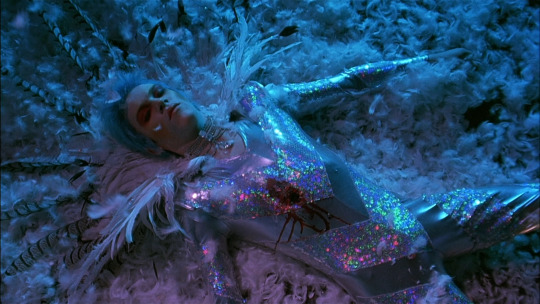
#todd haynes#velvet goldmine#ewan mcgregor#christian bale#jonathan rhys meyers#toni collette#michael feast#citizen kane#produced and abandoned#David Bowie#lou reed#oscar wilde#killer films#christine vachon#Musings#Oscilloscope Laboratories
15 notes
·
View notes
Text
Au bord des gouffres l’odeur d’un sourire
Souterrain blanc Fin de l'Art Divine doublure Global fashion triple-A Plus de sexualité naïve Prolo diverti-dressé Parade insensible On savait bien Profil algorithmique Bride-réalité sans reste dans les gamelles cérébrales Le reste ni dans l'Oeil-mémoire ni dans la main-gouvernance Hologramme-sensibilité Spectacle-autoritaire Nudités intouchables Publics-produits Ultra-centre Être-sur segment porteur écoresponsable 10000 €/m2 Espace détente Personnel service-entretien à proximité portée de commande biométrique Existence-suspension statistique Mégapoles-hamburgers à l'os Designer-béton Les Océans se perdent sur les bitumes Canalisations politiques Election des représentants de classe Vent off-shore 90’s Nous guettions les beaux jours sur les bas-côtés disponibles Années 2.0 Mobilier urbain coercitif Vies vidées d'existence Présence communicationnelle Soirée j'me lâche cocaïne méta-amphet ligne-base GHB Gai summer Université Chacun son rang Il en va de même des collaborateurs-collaboration open space Nation-start-up Cut-up social étiquetté sociétal Les marins portent leurs urnes funéraires loin des ports Plaisance Brétignolles Lotissement La belle pinède piscine L'océan Vous êtes bien rentré Merci bien C'est la règle du jeu La nuit sera hot cool Fin des programmes sur les écrans Dormez de face Sans commentaire Il n'y a plus de nuit sans technologie sans neuro-sciences expérimentales Tout est sous contrôle Fêtons Halloween mes petits fous Homo deus s'occupe de tout Il est le Tout et l'Unique le Cosmos la Monade Les mass media détiennent toute la réalité ensuite libre-choix Espace privatisé Billet d'entrée participatif Il est 7h à Singapour Le marché se structure L'effondrement se structure Banques centrales Injections sous-cutanées Quantitative easing Taux négatifs Pétro-dollar est confiance Routes énergétiques Sécurisation Crypto 2.0 Fonte cholestérol Soulier pinpin et marketing Suggestion en assurance vie Assurance en vie Décès Bonjour M. Le commissaire est-il bien mort À-t-il bien vécu Je veux le meilleur bois pour ses obsèques Oui il a bien sa carte pour pouvoir mieux vivre sa mort ses cotisations sont à jour Moi j'y arrive je vais souscrire Aussi Les dés ne prennent plus la nuit Les âmes s'élèvent en ascenseur Lune Lumière Île lumineuse Atlantique-viatique Sins les Allas B.O.C Chimay bleue Houle longue 9.0 Vito Temps-résine Obliques Pins maritimes Houles magnétiques Laisse de mer Naufrageur Piraterie Couverture de dune Ouvrir le monde pour un nouvel hasard pour un nouvel ailleurs Correspondances Cordes oscillantes Grand Rebond Epingle à cheveux-inflation La route-lumière Kerouac Natte de pluie L'on est porté par les eaux de ce que l'on soulève Puissance zarathoustrienne Errance couronnée Neutrino filant Fond diffus de l'Art Fond d'Art contemporain DRAC Institutions du bulbe sensitif Potin artistique Requiem sponsorisé Les dieux sont habiles Pouce-préhensile Quant à tout prendre Fumée de chilom creusé Bouche sur Terre Nagual devenu folklore pour voyageurs en petitesse Que rien ne dépasse Polir polir tous défauts Sécuritaire Confort Brain storming Subordination et associés Compagnies Multinationales Think tank des lèpres et salpêtres Corruption-lobbis sponsorisés Logos et données personnelles Cloud 1984 Big brother Big data Big boss-PDG Bruit de bottes-acouphènes Maintien de l'ordre légitime Judiciarisation indépendante Politique-tuyau-accompagnateur-process-vecteur en progression Désillusion Sublime déferlante Scélérate-système Accélération Toujours plus peut le maximum Résilience Infrabasse minimale Electronica Transe-goa Detroit Tekno Trip-hop Eno-Ambient HardTek Acid-House Hip-Hop Electro-Drecxiyan Trap Drum'n'Bass Drill’ n'Bass EDM IDM Dub Krautrock Les lèvres de la mer aspire tous les regards Toutes les mélodies du monde s'acheminent Les lézards ont leur rond de serviette et pantouflage Venez comme vous êtes Je le vaux bien Tant que vous croyez à vos textes Êtes vous prêts à faire des lectures Les expositions de peinture permettent de vendre des livres J'ai remarqué cela Enfin tout est noter sur le site lisez bien Non mais écoutez moi Ici c'est l'auberge sans l'orage La calèche sans chevaux Le beau fixe Mais vous savez faut trimer mon p'tit père Kétamine Les canassons dorment pour oublier le large Liquide- neuroleptique sur la ville Année pluvieuse L'eau roule sur les plages de béton Les techniciens-gestionnaires-globalistes balayent les horizons Tout est question de mouvement C'est plus sûr Plus rassurant Tournez tournez il n'y a plus de possibilité tout est là Regardez nous Regardez vous Heure d'hiver Heures de terre Balustrade Loge Espace 1ère classe VIP Masterclass des artistes Les lieux peuplent parfois les Hommes Plan local d'urbanisme Espace petite enfance-jeunesse-3ème âge Service social Une chemise comme celle-là permet la guerre chirurgicale Allumez la télé on vous répondra Fabrique Sup de co Journaliste de studio Passage maquillage-habillé par Ne tuez pas les gens attendez qu'ils se rendent Epuisement Urne funéraire Nouvelles routes de la soie PROTEGER LES ROUTES ENERGETIQUES Toi ami mon ami Moi ami mon ami Vitrine-démocratie-and co arrière-cour-diplomatique Transparence du jour La vérité est nue Pouvoir intermédiaire La base crépite les étoiles pétillent Porte de La Chapelle Les visions ne se multiplient pas comme les pains Initié-Nagual Peyotl Datura Grenouille totémique L'Amazonie n'a plus qu'un poumon Transhumanisme flamboyant Homme-sciences Sauveur Les algorithmes deep learning n'auront bientôt plus assez du monde CE MONDE REDEVENU MULTIPOLAIRE DOIT S'UNIFIER SOUS UNE GOUVERNANCE GLOBALE Tout est si confortable Vous êtes si bien avec Vous ne voudriez pas quand même en va-nu-pieds Synchronisation Horloges atomiques Logos idéologiques Habiter plain-pied permet de ne pas avoir besoin d'ailes FIN DE L'HISTOIRE Homo economicus sur les voies Homo deus Quelle belle exposition Mandorle Homme en majesté devenu lueur divine Priez pour nous autres conducteurs élairés du saut de l'ange Tout est REPRESENTATION Les forêts n'ont plus d'épaisseur Nous lisons tous les signes Tout est en cours de traitement IA Surtout pas d'inquiétude tout est sous contrôle jusqu'à plus soif Mieux vaut le futur
0 notes
Text
The 1932 Coupe that Wants to be a Lincoln
“Roy kept telling me, ‘Come up with a theme.’”
Roy was right. Great street rods, high-buck, low-buck, pro-built, or homebuilt, follow a theme. It might be as simple as ’50s styling or it might be as imaginative as this 1932 Ford three-window coupe, built for Larry Carter by Roy Brizio Street Rods in South San Francisco.
Larry and Roy had collaborated on several other cars in the past. Those include a Deuce roadster and a 1934 Ford woodie. In 2009, they teamed up to take a theme to the next level. “What would Enzo do?,” was the hypothetical question. A dark red 1933 Ford roadster with the soul (and engine, gauges, and interior) of a Ferrari was the tangible answer. Work began on the coupe in the summer of 2015. Following Roy’s charge to “come up with a theme,” and inspired by the success of the 1933, Larry got the idea to inject this latest rod with some Lincoln flavor. “After all,” Larry explains, “a Lincoln is an upgraded Ford.”
Deuces are something of a signature vehicle for Roy Brizio Street Rods and this full-fendered three-window was built from a steel Brookville body. Rootlieb provided a steel 1932 Ford 25-louver one-piece hood, and a stainless steel insert from Dan Fink Metalworks fills the grille shell. Andrik Albor and Jack Stratton, two of Brizio’s talented fabricators, performed the chop, taking a just-right 3 inches out of the coupe top. Guy Ruchonnet put his touch to the rest of the sheetmetal, perfecting it prior to paint.
The paint and the wheel covers are the first visual clues to the coupe’s Lincoln alter ego. The wheel covers are from a 1957 Lincoln Premiere. The paint keeps people guessing unless they recognize it as Rose Metallic, a 1958 Lincoln color. Darryl Hollenbeck at Vintage Color Studio in Concord, California, painted the coupe using PPG Envirobase products. A subtle black pinstripe was added to highlight the beltline bead.
Finishing touches to the exterior include headlights from SO-CAL Speed Shop and LED 1932 taillights from Johnson’s Hot Rod Shop. The swan neck side mirrors are from SO-CAL as well. Front and rear bumpers and door handles came from Bob Drake Reproductions. Sherm’s Custom Plating in Sacramento took care of chrome.
Plated and polished components were used extensively on the chassis as well. The Brizio-built frame is fully boxed and beefed up with a 1-1/2-inch tube X-member. Kugel Komponents front and rear independent suspension parts, including coilover shocks and antiroll bars at both ends, upgrade the performance of Larry’s “upgraded Ford.” Other practical performance improvements include rack-and-pinion steering and Wilwood disc brakes; a Wilwood master cylinder and proportioning valve are pumbed to 12-inch front and 10-inch rears rotors. Those Premier wheel covers dress up 15×7 and 15×9 steel wheels from Wheel Vintiques. Retro-style 560-15 and 820-15 wide-whitewall tires are from Coker Tire.
Larry told us that he was originally hoping to continue the Lincoln theme with a Lincoln engine to power his Deuce. As it turned out, he was not able to locate one that was suitable for the project. However, a 402ci Ford engine from Roush Performance is a more-than-satisfactory alternative. As set up in the coupe, the engine is rated at just below 400 hp. That’s more than the Ferrari engine in Larry’s 1933 roadster (in stock form) and definitely plenty of power for pulling the 1932 coupe—and the original 1956 Continental Mark II valve covers dressing up the Roush aluminum cylinder headers keep the Lincoln theme going under the hood. An Edelbrock intake manifold and 650-cfm carburetor feed the 402, topped with a Billet specialties 14-inch Vintage series air cleaner. Taylor wires carry spark from the MSD ignition to light the charge. Exhaust is drawn through Sanderson 1-5/8-inch headers to Jack Stratton’s 2-1/4-inch custom exhaust system corked by Stainless Steel Specialties tube mufflers. To keep things cool, a Spal fan pulls air through a Walker brass radiator. A TREMEC TKO600 transmission with a Modern Driveline clutch and Lokar shifter backs up the 402. A Driveline Service driveshaft and 3.70 rear gears with limited slip deliver torque to the rear wheels.
The Lincoln theme is strongest inside the car. Automotive interior designer Sid Chavers has contributed to many Brizio projects, and his work on Larry’s coupe is amazing. The custom bench seat was upholstered in two shades of rose leather with cloth inserts. Chavers used authentic Lincoln fabric, stitching it with a button tuft pattern that resembles 1960 Lincoln upholstery. The combination was repeated on the custom door panels.
The steering wheel is from a 1947 Lincoln and the shifter knob features the Lincoln star design. An engine-turned 1932 Lincoln dash insert was added to the Brookville dash and filled with blackface gauges built for the car by Classic Instruments. A tach is mounted on the ididit tilt steering column. A below-the-dash panel was fabricated to house controls for the Vintage Air A/C system. The retractable billet vents are from Moal Coachbuilders. Jim Vickery at Brizio’s installed the Enos Custom Components wiring system.
Larry’s Lincoln-themed three-window was completed a few months before the 2017 Grand National Roadster Show, where it was one of six or seven street rods in the Brizio booth. Unlike during the GNRS, the Deuce is no longer “for display purposes only.” It was built to drive. Larry’s wife, Juana, insists on it. Juana helped select the coupe’s Rose Metallic paint, and nicknamed the car “Miss Lila Rose.” When the Carters get the urge to take a cruise in Los Gatos, California, in one of the 70 cars in Larry’s collection, he knows what Juana will say: “Let’s take Miss Lila Rose.”
The post The 1932 Coupe that Wants to be a Lincoln appeared first on Hot Rod Network.
from Hot Rod Network http://www.hotrod.com/articles/1932-coupe-wants-lincoln/ via IFTTT
0 notes
Photo
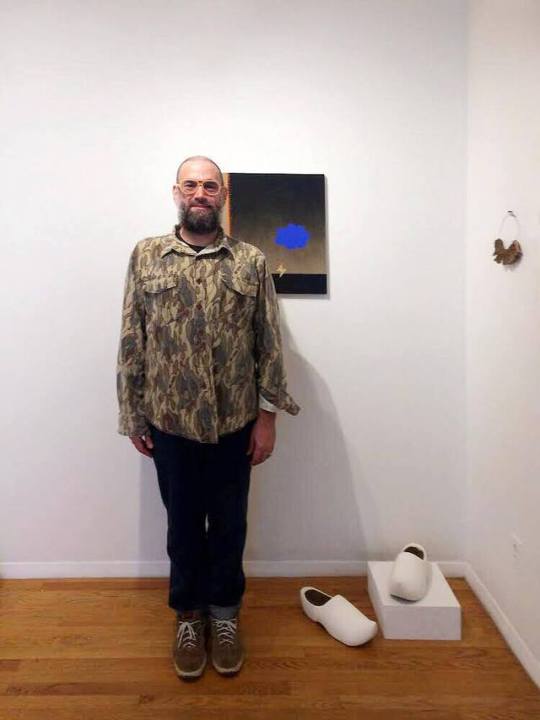



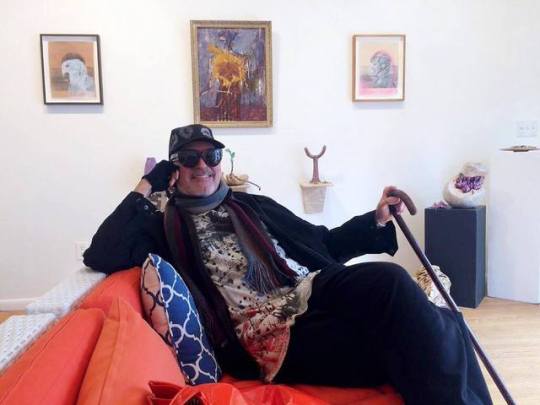

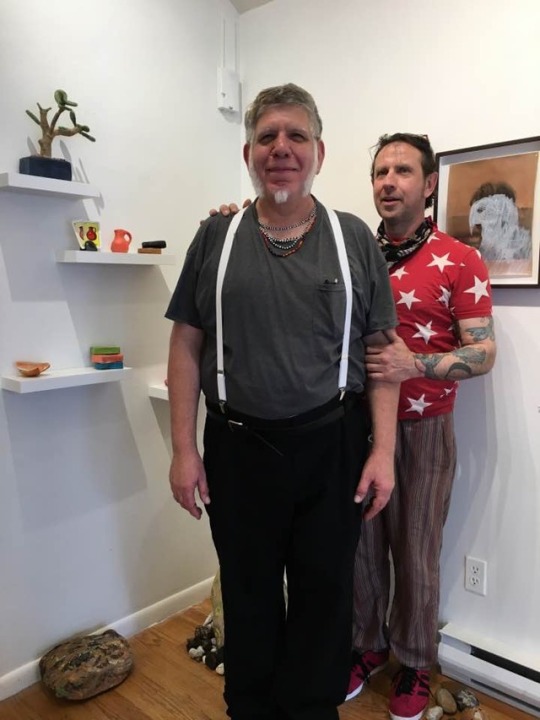
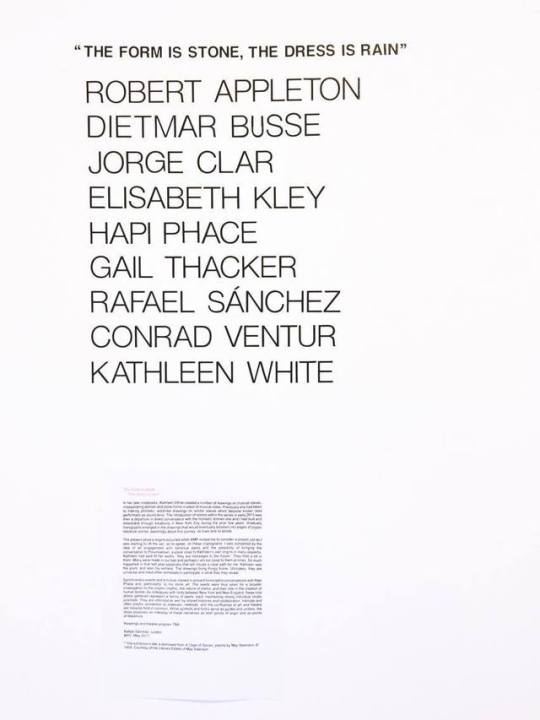
The form is stone, the dress is rain at AMP Gallery, Provincetown
Connection abounds….
Last winter, I had presented a performance titled Show and Tell at Gail’s Gene Frankel Theatre fundraiser, which led to Rafael and I engaging in a conversation about symbols—a point of convergence in our work.
For the performance, I had used one of the Magic Mirror notebooks we use for drawing at Joel’s. In this particular one, I had made a series of 33 drawings using Posca markers Bubi gave me. The drawings represent memories of my childhood and metaphysical musings. Some of them nod to Bubi’s Hologram video, in which I play a character called “Lord”.
For Show and Tell, as I flipped through those drawings, I recited the lines of a poem I wrote specifically for the performance, this after singing a few lines from Sara Montiel’s “Maniquí parisien”. Rafael, who had also participated in the Gene Frankel fundraiser by reading a poem, asked me if I would like to do the performance in a show he was organizing in Provincetown.
I told him I would be honored to do so. Rafael explained to me the idea for the show stemmed from conversations he and Hapi Phace had about rocks, and also talked about how Kathleen would use pentagram lines to write series of cryptograms. I remember the first time I had seen Kathleen’s work was at Wild Project in February 2016—I was drawn to her pieces because of her use of symbols and typewriter keys to create iconographs, all of it very dear to me….
The title of the show, “The form is stone/the dress is rain”, is a line from a poem by May Swenson, hailed poet of the 20th century who would write in an iconographic style. Artist friends, poetry, iconography—it all started coming together. Rafael mentioned I could also show a portrait I drew of Gail on New Year’s Day at Joel’s...he was also there that night and remembered it. I loved the idea of showing a drawing from our dear Magic Mirror circle.
I was so thrilled to be in such great company…the show would also include works by Kathleen White, Robert Appleton, Dietmar Busse, Elisabeth Kley, Hapi Phace, Rafael Sánchez, Gail Thacker and Conrad Ventur…all artists whom I admire tremendously. I was also elated to be in a show that would also be Hapi’s first gallery exhibition since 1986, when he exhibited at Edgar Oliver’s Pompeii Gallery in the East Village. What a thrill to get to know him better, really a full circle of dreams coming true as when I first moved to New York in 1987, my favorite thing in the world was the Whispers drag nights at the Pyramid, where I was especially fond of Hapi’s freewheeling, perfectly-cadenced and dazzlingly imaginative MCing.
A couple of weeks before the show, Scooter had sent me a photo of a pair of Dutch klomps he had painted, and I thought I would give him the ones Mom and Dad bought during a trip to Volendam, Holland, in 1978. He mentioned I should give them a coat of gesso, which my roommate Michael prepared and strained for me and I then applied lovingly to the shoes. Rafael stopped by the ranch and saw how the shoes looked—to me, they are like bisque porcelain—and mentioned we should take them to the show. Every time I saw how they now looked, I was in awe of the sense of something so familiar being transformed into an archetype. The unfinished piece was suddenly finished.
So there they were…the klomps, the drawing of Gail, the performance notebook hanging on the wall from a dowel—across from one of Kathleen’s late notebooks 2012-2013—all the objects coming together, morphing into something new.
Dietmar and I, on the suggestion of Gene Fedorko, made arrangements to stay overnight with Ms. Meade, who was most kind and welcomed us in her guest apartment. Later on, we found out while visiting that the converted garage we stayed in was used by Yves Klein as a studio! We had bought tickets to go to Boston on the Megabus to then connect with the ferry to Provincetown, but on our travel day, which was the day of the opening, September 22, hurricane José was whirling in the Atlantic near the area and so we knew beforehand we would have to take a bus provided by the Bay State Cruise Company.
We got to the Megabus terminal at 7:15 a.m., grabbed a bite at a deli and got on the bus. The bus got delayed and we got to Boston at 1:18 instead of 12:30. So, we missed our bus connection and stopped at the South Street Diner and had shrimp and chips.
An Uber took us to the ferry terminal, and we had to wait an hour for the next bus out, which was at 5 p.m. We waited at a Dunkin Donuts as the vernal equinox happened, to the tune of songs by Katy Perry and Selena Gómez being piped in. Dietmar did some drawings while I did some writing.
Back on the bus, we knew we were going to arrive close to 9…the climate was windy, gray and blustery…and the clock ticked on. We called Miss Meade and told her our whereabouts; she offered to pick us up at the ferry terminal. I was also in touch with Rafael to let him know where we were on the road, people were at the opening waiting for the performance. Something inside of me told me we would get there in the nick of time.
As we passed Shrewsbury, I started getting ready for the performance. To me, it had already started right there, on the bus. We got to the terminal and looked for Miss Meade, who dropped us off at the entrance of the AMP Gallery at 8:50—the opening would be over at 9. Dietmar and I walked in; I greeted Rafael and he almost jumped out of the sofa. We had been talking on the phone, braving an intermittent phone signal to figure out an ETA.
I said hello to Hapi, Tony Stinkmetal and Bobby Miller and checked in with gallerist Debbie Nadolney. She mentioned Louis, a benefactor who had arrived from Amherst, was going to take us out to dinner at The Muse and the reservation was about to run out.
I put my bag down and got ready. Rafael introduced me and I grabbed the notebook from the wall and did the performance; Bobby videoed.
Much excitement abounded after the suspense of the performance to arrive, I caught my breath and we all headed on to The Muse. Tony was commenting how he had found the performance inspirational; I was so grateful for this. It was a dreamlike meal.
After dinner, Dietmar went with Bobby in his car to be dropped off at Miss Meade’s. Hapi and Tony called it a night and Rafael and I walked around Commercial Street for a while, reeling with happiness. We went to listen to Scream Along with Billy at the amazing basement Grotta Bar doing an astounding concert of Brian Eno covers. We stopped in front of a store called Kmoe and took a selfie; the store was full of amazing industrial lamps and we took more photos. We stood in the parking lot and called Gail, who was in Grand Central Terminal back in New York…hearts jumping with joy.
We stood by the water near the parking lot and listened to the wind and saw the distant lights of nearby towns through the fog.
Rafael drove me back to Miss Meade’s and I lay down to sleep. The next day Bobby would take our portraits! Hooray! (Dietmar took my photo next to Klumpen and in front of Rafael’s The Story of the 1st Painting (part one, number one) at the gallery. I was wearing a Jim Teeny Shadow-Camo shirt, Wrangler jeans, and Ferragamo boat shoes.)
As Rafael put it later on Facebook, it was a magical night:
Thank you, the universe, the artists, everyone that helped make this a reality and all who supported our efforts. We set up and opened through the horizontal rain of tropical storm José. The opening settled upon a perfectly misty, New England fog. Meanwhile, ferries were suspended for two days due to the choppy waters as the provided shuttle bus lumbered up the cape with Dietmar and Jorge Clar just in time for Jorge to inaugurate the show with his stunning visual poem! It was amazing. And if that wasn't enough, an unassuming patron arrived miraculously out of the foggy night to toast us and take us all out to dinner by the sea. The following day renowned photographer Bobby Miller further inaugurated the event with beautiful studio portraits of the artists that were able to attend; Hapi, Tony, Dietmar and of course Jorge marking the proceedings with a truly regal quality. Sun came on Sunday in time for a swim in the ocean, my first and probably last for the year. I feel humbled and blessed. I've not posted anything here since leaving NYC last week. Happy Fall everyone, Cape Cod is extraordinary this time of year. Exhibition continues through October 15.
#artdiary#artdiaries#provincetown#ampgallery#performanceart#performance#painting#drawing#rafaelsanchez#debbienadolney#dietmarbusse#conradventur#elisabethkley#gailthacker#robertappleton#hapiphace#kathleenwhite#symbols#notebook#jorgeclardiary
0 notes
Text
J-12 : L’insolite suspension Hat, de Eno Studio
Déjà la moitié ! Plus que douze jours avant Noël ! Nedgis vous propose aujourd’hui un luminaire aussi particulier qu’élégant. La suspension Hat signée Mars Design Studio et éditée par la maison d’édition française Eno Studio est vraiment atypique et sait se faire remarquer. Inspirée de la forme du célèbre couvre-chef : la capeline, cette suspension apporte humour et élégance à votre intérieur et…
View On WordPress
#lampe eno studio#lampe Hat#suspension capelline#suspension chapeau#suspension chapeau eno studio#suspension Eno studio#suspension Hat
0 notes
Text
Le salon Maison et Objet a eu lieu du 20 au 24 janvier 2017 à Paris. Un lieu incontournable pour les professionnels de la décoration et du design !
L’équipe Nedgis, y était, et vous fait découvrir une sélection de ses découvertes…
En phase avec l’actualité, GoodNight Light présente sa nouveauté .. un astronaute, désarticulé en plusieurs couleurs disponibles … A découvrir !
Nedgis a aussi adoré une nouveauté de Moaroom designé par David Trubridge.
La suspension Navicula du designer neo-zélandais..
Zoom sur des luminaires eco-responsables de la marque It’s about Romi. La collection Good&Mojo est faite de matériaux durables comme du papier recyclé ou encore du bambou. Pour toutes les lampes achetées, une partie est reversée à la fondation “WakaWaka Fondation”.
Coralie Beauchamp est un designer français qui est une ambassadrice du fait main, ses luminaires prônent une ethnique artistique et poétique …
La marque italienne Uashmama a épaté de nombreux professionnels avec ses objets divers, fait de papier. Nedgis a adoré ses lampes …pour un style simple et original !
La marque néerlandaise, Tonone, a dévoilé ses suspensions Atlas lors du salon Maison & Objet où le verre s’est mis à nu …
Po! Paris est une marque qui, depuis 2008, créée des luminaires originaux et ethniques.
Les abat-jour feutrés sont créés en Albanie par des femmes et sont assemblés en France dans un atelier parisien pour un résultat pur et design.
La collection UTU de Mambo nous dévoile des luminaires aériens et chics où les formes géométriques jonglent avec le design…
La marque A modern Grand Tour, nous fait voyager dans une ambiance originale et légèrement exotique… Des luminaires à découvrir !
La marque MadebyTinja souhaite transmettre une relecture contemporaine des traditions artisanales tunisiennes.. pour un résultat amusant et original !
La marque Boboboom revendique une démarche de détournement et de valorisation d’objets déjà existants avec un souci environnemental affirmé : arrêter de jeter pour préserver la planète.
Eno Studio a dévoilé de nombreuses nouveautés lors du salon Maison et Objet. Des suspensions Gambi en verre, avec une inspiration des années 30 … A mettre en grappe ou bien seule.
Pour plus d’informations, veuillez nous contacter par ici
Nos coups de cœur du salon “Maison et Objet” 2017 Le salon Maison et Objet a eu lieu du 20 au 24 janvier 2017 à Paris. Un lieu incontournable pour les professionnels de la décoration et du design !
0 notes